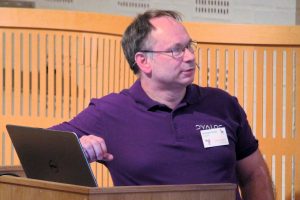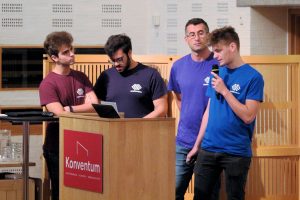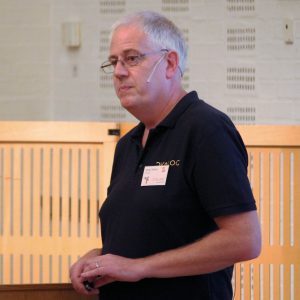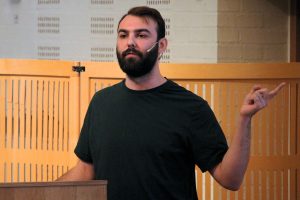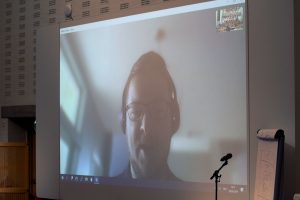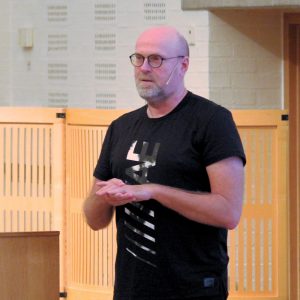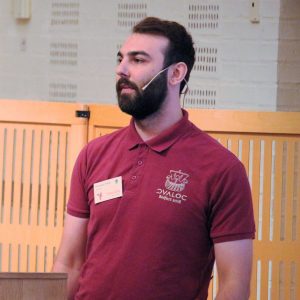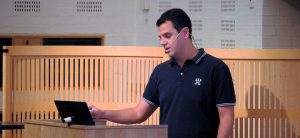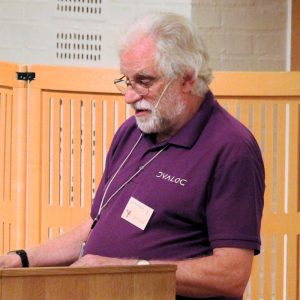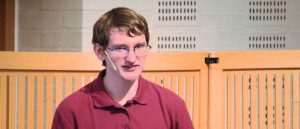The release of the final set of videos from the Dyalog ’19 user meeting in Elsinore slipped into 2020, thus providing me with a perfect opportunity to wish you all a Happy New Year from all of us at Dyalog! We are wrapping up with recordings from the Prize Ceremony for the 11th annual Problem Solving Competition and the the Young APLers’ Panel.
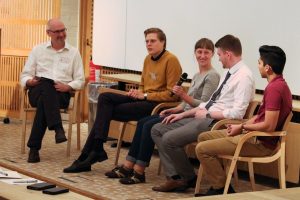
The young APLer’s panel. From left: Stephen Taylor, Alve Björk, Yuliia Serhiienko, James Heslip and Josh David
I can’t think of a better way to kick off the new year than watching newcomers to APL talk about how they got started! With Stephen Taylor as host, our panellists Alve Björk (Uppsala University, Sweden), James Heslip (Optima Systems Ltd, UK), Josh David (Dyalog Ltd, USA) and Yuliia Serhiienko (SimCorp, Ukraine) discuss how they first encountered APL, their perception/experience of the language and what they would like to see APL vendors and the APL community working on in the future.
Every year, the annual APL Problem Solving Competition entices students to learn APL and try to win significant cash prizes and a trip to the Dyalog user meeting. This year, Dyalog brought the entire contest “in house” rather than using an external company to host it. We developed our own interactive contest site, which allowed contestants to get immediate feedback on potential solutions to Phase 1 problems. In addition to making it more fun – and a lot easier – to submit solutions, the new site saved Dyalog a lot of time by pre-verifying Phase 1 solutions. As Brian Becker explains in his talk leading up to the prize ceremony, the project gave us an opportunity to test a lot of our own components by building a fully operational application entirely in Dyalog APL. Gitte Christensen, CEO of Dyalog Ltd, awards the prize for the best professional entrant to Torsten Grust and the grand prize to Jamin Wu.
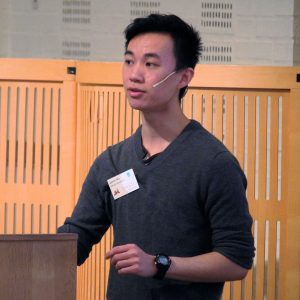
Grand Prize winner Jamin Wu
I never cease to be amazed by the quality of presentations by winners of the contest. The youngsters of today seem able to learn to write APL code that many professionals would be proud to have written, in a few weeks – sometimes only days.
Jamin Wu is a medical student at Monash University in Australia, but also a keen programmer. His presentation on how he won the 11th annual APL Problem Solving Competition was one of the clearest and most impressive acceptance speeches by a winner of the competition that I have had the privilege to attend. In a very short amount of time, Jamin has been able to get an astonishing grip on the benefits of APL, and write some of the most elegant APL code I have ever seen. We’re sad that he won’t be joining the community as a full-time APL programmer any time soon; the good news is that the medical community in Australia will soon have a very competent young doctor, able to use computers very effectively to assist him in research and analysis of data!
Summary of this week’s videos:
- U12: Young APLers Panel (Stephen Taylor with Alve Björk, Yuliia Serhiienko, James Heslip and Josh David)
- D15: The APL Problem Solving Competition – How, What and Who (Brian Becker)
- U13: How I Won the APL Problem Solving Competition (Jamin Wu, Monash University Australia)
That is (almost) the end of the Dyalog ’19 videos; at Tomas Gustafsson’s request, we are holding back the release of his exciting yarn about how APL was used to locate the wreck of the M/S Irma until the upcoming documentary has been aired on Finnish TV.
It is already time to think about Dyalog ’20, which will be held in Olhão, Portugal, from 11th-15th October. Follow us on social media (Facebook, Twitter, LinkedIn) to be kept informed about this and all things related to Dyalog!


 Follow
Follow